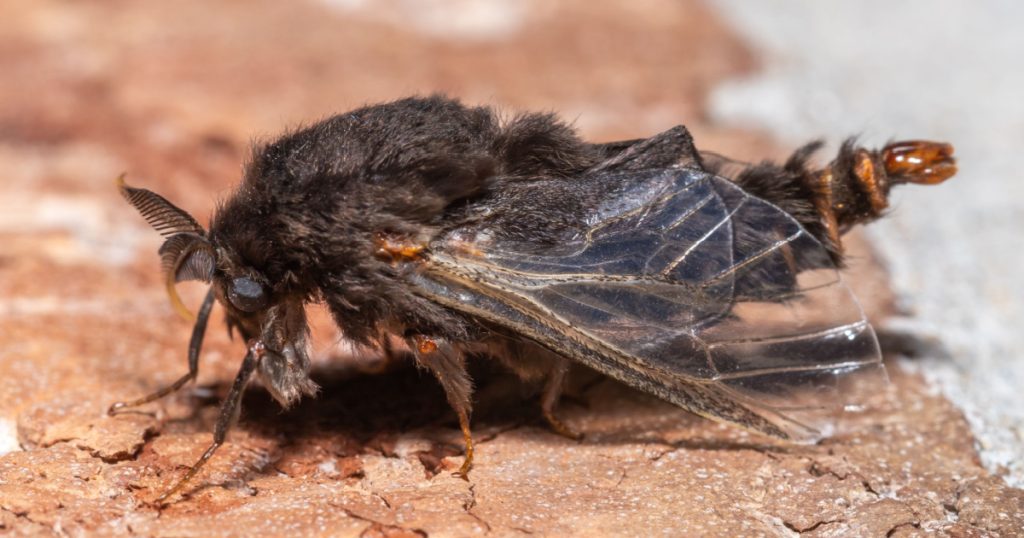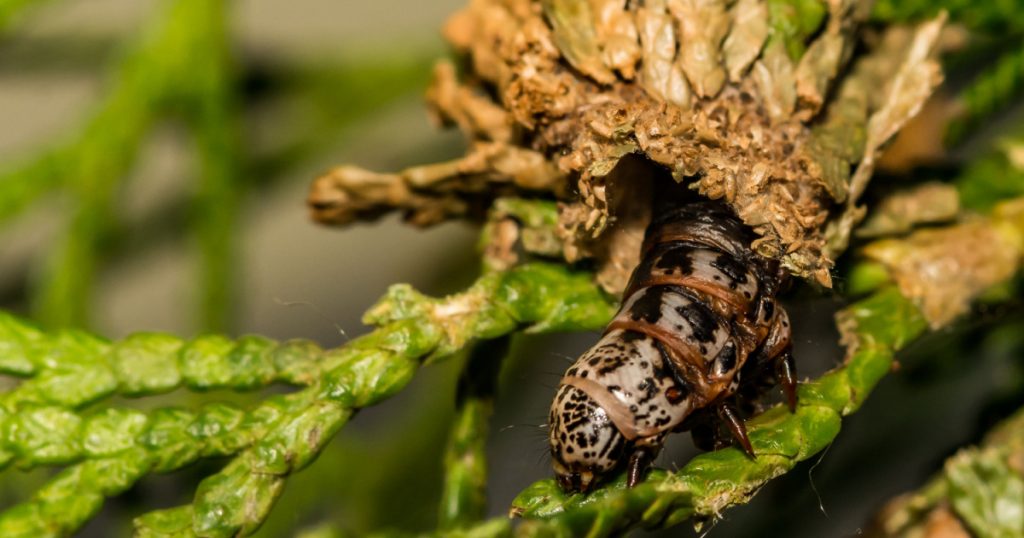Anyone who’s ever had an issue with an Evergreen Bagworm infestation knows the devastation they bring to trees. The poor trees become increasingly sparse in their pine needle distribution until they eventually lose them all and die. This is a sad end to the beautiful evergreen trees we all love. Thankfully, there are ways to save your trees if you know what to do.
Advertisement
The Evergreen Bagworm: The Silent Killer of Trees
In the world of pests that threaten the health and beauty of trees, few are as notorious as the Evergreen Bagworm. Despite its name, the Evergreen Bagworm is not a worm but a moth in its larval stage. These deceptive creatures can wreak havoc on various evergreen and deciduous trees, causing significant damage and even death if left unchecked. (1)
Understanding the Evergreen Bagworm

The Evergreen Bagworm, scientifically known as Thyridopteryx ephemeraeformis, is a species of moth that belongs to the family Psychidae. These small, inconspicuous creatures owe their name to the distinctive protective casing they construct around themselves, known as a bag or case. Bagworm larvae attach bits of plant debris, such as leaves, twigs, and bark, to their bodies using a silk-like thread they produce. Over time, this structure grows and becomes their portable shelter and means of camouflage, making them appear as small bags hanging from tree branches.
Life Cycle of the Evergreen Bagworm
Effective management of the Evergreen Bagworm depends on knowledge of its life cycle. These moths’ reproductive cycle starts when the female adult lays her eggs inside her own bag. The bag is then left hanging on the tree after she passes away.
These eggs are dormant all winter long, hatching in late spring or early summer to produce tiny larvae. After hatching, the larvae leave the bag in search of an appropriate host tree. They start building their bags once they find a suitable location, using silk produced by special glands in their bodies.
The bags start out small and unnoticeable, but as the larvae develop, they periodically emerge to replenish their casing with additional plant debris. These cases grow bigger and more obvious over time.

The larvae go through several molts as they grow, shedding their skin each time to accommodate their expanding size. A new bag is built for each instar, or stage, of growth. Late summer or early fall is when bagworm larvae typically reach their final instar. The larvae have reached this stage, which lasts for about six weeks, and are prepared to pupate.
Within the protective case, the moth changes from its larval stage to its adult stage. Invisibly hidden, the pupae grow inside the bagworm cases. By making a circular opening in the case, the adult moths crawl out after about two weeks. The larger, wingless female moths stay close to the original tree, while the males, which are darker, smaller, and have clearer wings, fly off in search of females.
The Destructive Nature of the Evergreen Bagworm
Evergreen Bagworms may at first glance seem harmless, but if they are not controlled, they can seriously harm trees. These pests are voracious eaters who prey on various tree species’ foliage. They hide until the infestation is severe thanks to the protection and camouflage offered by their bags.
Defoliation brought on by bagworm larvae feeding on the tree’s leaves makes it more difficult for the tree to photosynthesize and produce the nutrients it needs to grow and survive. The feeding activity also weakens the tree, making it more susceptible to other illnesses, pests, and environmental stressors. Evergreen Bagworms can lead to tree decline and, in some cases, tree death if left untreated.
Managing Evergreen Bagworm Infestations
The health of affected trees must be preserved through prompt and efficient management in order to reduce the harm brought on by Evergreen Bagworm infestations. Consider the following strategies and tactics:
- Manual Removal: For small infestations, manually removing the bagworms by hand can be an effective solution. Carefully inspect the tree branches and identify the bags, which are often mistaken for small cones. Gently remove the bags, making sure not to drop them on the ground to prevent potential reinfestation.
- Pruning and Destruction: If an infestation is more widespread, pruning the affected branches and properly destroying them is recommended. Bagworms may also construct bags on structures near the tree, such as fences, which should be inspected and removed if necessary.
- Biological Control: Certain natural predators, such as birds and parasitic wasps, feed on bagworms and can significantly reduce their population. Encouraging biodiversity in your garden can help establish a healthy ecosystem that supports these natural predators.
- Chemical Control: In cases of severe infestation or when other methods prove ineffective, chemical control may be necessary. Insecticides specifically formulated for bagworm control can be applied to the foliage of affected trees following the manufacturer’s instructions. It is important to note that chemical control should be approached with caution and only used as a last resort, considering the potential environmental impact.’
Maintaining Healthy Trees
When it comes to Evergreen Bagworms, prevention is always preferable to treatment. You can lessen the chance of infestation and improve the general health of your trees by putting into practice the following practices:
- Regular Inspection: Regularly inspect your trees, especially during spring and early summer, to detect any signs of bagworm infestation. Early detection can make management much easier and prevent widespread damage.
- Good Tree Maintenance: Properly maintain your trees by pruning dead or damaged branches and keeping them well-watered and fertilized. Healthy trees are more resistant to infestations and can recover more effectively.
- Remove Bagworm Bags: If you come across any bagworm bags during your inspections, promptly remove and destroy them. This proactive measure can prevent the spread of these pests to other trees.
- Avoid Overcrowding: Maintain proper spacing between trees and avoid overcrowding to enhance air circulation and reduce the risk of infestation.
- Monitoring Surrounding Vegetation: Keep an eye on neighboring trees and plants, as bagworms can migrate from one host to another. Take necessary precautions if you notice signs of infestation nearby.
The Bottom Line
Even though the Evergreen Bagworm is tiny and barely noticeable, it has the ability to silently kill trees. You can defend your trees from these sly intruders by being aware of their life cycle, appreciating their destructiveness, and putting good management practices in place.
In order to stop infestations and maintain the beauty and vitality of your landscape, regular inspections, preventative measures, and maintaining healthy trees will go a long way.





